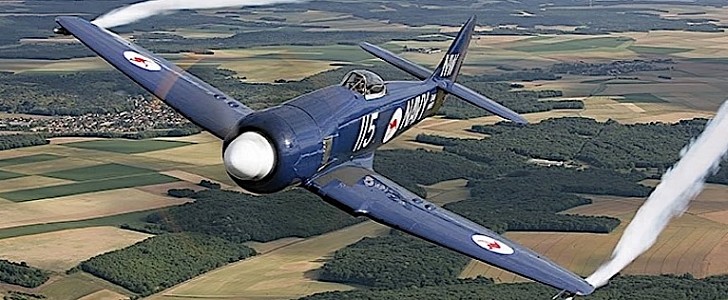Seen as the last propeller-driven fighter aircraft to be deployed by the Royal Navy, the British-made Hawker Sea Fury may have missed most of the Second World War, but it did see its fair share of combat.
Manufactured by the same company that made the mighty Hurricane, one of the stars of the Battle of Britain, the Sea Fury made its first flight in late 1944, and was seen in the skies well until 1968, last in the hands of the Burmese Air Force.
Made to be both a carrier and land-based aircraft, the Sea Fury was wildly successful in the years following the war, being deployed by a number of countries, including less popular ones today such as Cuba, Iraq, and Pakistan.
Armed with things like 20 mm autocannons, bombs, and even rockets later on, the Sea Fury was mostly a single-seater, but some air forces had them converted two-seaters. Either way, the airplane was capable of reaching speeds of 460 mph (740 kph) and fly at altitudes of up to 18,000 ft (5,486 m) for as much as 780 miles (1,260 km) on a single outing.
The planes delivered to Iraq – about 55 of them – were land-based fighters. They unofficially became known as the Baghdad Furies, and this is one of them.
Manufactured in 1949, this Fury was delivered to the Fleet Air Army, one of the Royal Navy’s five fighting arms, that same year. In 1958 it was converted to a two-seater and delivered to the Arab country. Most importantly, it was taken out of Iraq in 1979, and shipped to the United States, in the hands of private collectors. Decades later, it was restored and eventually it headed back to Europe, this time to France.
Sporting the original airframe and a Pratt & Whitney engine, the Sea Fury is now for sale on a specialized website. The asking price is 1.6 million euros, or the equivalent of $1.9 million at today’s exchange rates.
Made to be both a carrier and land-based aircraft, the Sea Fury was wildly successful in the years following the war, being deployed by a number of countries, including less popular ones today such as Cuba, Iraq, and Pakistan.
Armed with things like 20 mm autocannons, bombs, and even rockets later on, the Sea Fury was mostly a single-seater, but some air forces had them converted two-seaters. Either way, the airplane was capable of reaching speeds of 460 mph (740 kph) and fly at altitudes of up to 18,000 ft (5,486 m) for as much as 780 miles (1,260 km) on a single outing.
The planes delivered to Iraq – about 55 of them – were land-based fighters. They unofficially became known as the Baghdad Furies, and this is one of them.
Manufactured in 1949, this Fury was delivered to the Fleet Air Army, one of the Royal Navy’s five fighting arms, that same year. In 1958 it was converted to a two-seater and delivered to the Arab country. Most importantly, it was taken out of Iraq in 1979, and shipped to the United States, in the hands of private collectors. Decades later, it was restored and eventually it headed back to Europe, this time to France.
Sporting the original airframe and a Pratt & Whitney engine, the Sea Fury is now for sale on a specialized website. The asking price is 1.6 million euros, or the equivalent of $1.9 million at today’s exchange rates.






